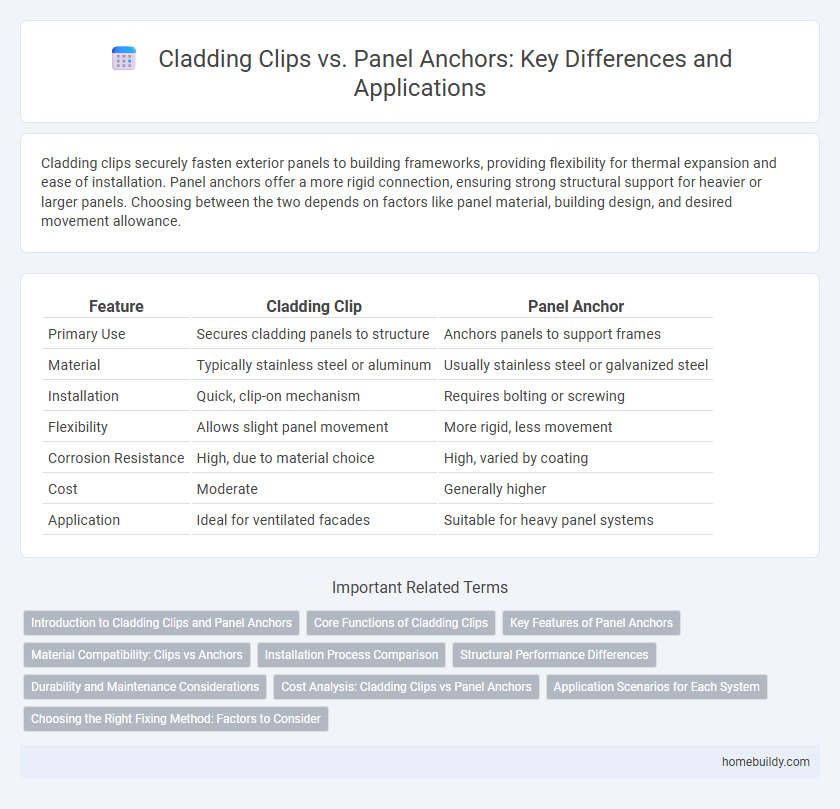Cladding clips securely fasten exterior panels to building frameworks, providing flexibility for thermal expansion and ease of installation. Panel anchors offer a more rigid connection, ensuring strong structural support for heavier or larger panels. Choosing between the two depends on factors like panel material, building design, and desired movement allowance.
Table of Comparison
| Feature | Cladding Clip | Panel Anchor |
|---|---|---|
| Primary Use | Secures cladding panels to structure | Anchors panels to support frames |
| Material | Typically stainless steel or aluminum | Usually stainless steel or galvanized steel |
| Installation | Quick, clip-on mechanism | Requires bolting or screwing |
| Flexibility | Allows slight panel movement | More rigid, less movement |
| Corrosion Resistance | High, due to material choice | High, varied by coating |
| Cost | Moderate | Generally higher |
| Application | Ideal for ventilated facades | Suitable for heavy panel systems |
Introduction to Cladding Clips and Panel Anchors
Cladding clips are specialized fasteners designed to securely attach exterior cladding materials to building frameworks, ensuring uniform load distribution and allowing for thermal expansion. Panel anchors serve a similar purpose but are typically used for heavier, larger panels and provide adjustable fixing points to accommodate panel movement and alignment. Both components are essential in modern facade systems, influencing the durability and aesthetic quality of cladding installations.
Core Functions of Cladding Clips
Cladding clips serve as essential fastening components designed to securely attach exterior cladding materials to building structures, ensuring alignment, stability, and ventilation. Unlike panel anchors, which primarily provide rigid anchorage for heavier panels, cladding clips accommodate thermal expansion and contraction, reducing stress and potential damage to the facade. Their core function includes enabling quick installation, maintaining facade integrity, and enhancing the longevity of facade systems through flexible yet secure connections.
Key Features of Panel Anchors
Panel anchors provide superior stability and load distribution compared to cladding clips, enabling secure attachment of facade panels to structural frameworks. These anchors often feature adjustable mechanisms for precise panel alignment and enhanced resistance to wind and seismic forces. Their robust design supports heavier panels and contributes to the overall durability and safety of exterior cladding systems.
Material Compatibility: Clips vs Anchors
Cladding clips are typically made from stainless steel or aluminum, ensuring excellent corrosion resistance and compatibility with a variety of facade materials such as wood, metal, and composite panels. Panel anchors often utilize galvanized steel or zinc alloys, which may be less resistant to corrosion and potentially reactive when used with certain materials like aluminum or copper, causing galvanic corrosion over time. Choosing clips over anchors enhances material compatibility by minimizing electrochemical reactions and extending the lifespan of the cladding system.
Installation Process Comparison
Cladding clips offer a streamlined installation process by securely fastening panels with minimal tools and reduced labor time, enhancing efficiency on-site. Panel anchors require more precise alignment and often necessitate additional components, increasing installation complexity and duration. Choosing cladding clips can significantly reduce overall project timelines due to their simplified attachment method and adaptability to various panel types.
Structural Performance Differences
Cladding clips provide enhanced flexibility by allowing slight movement and accommodating thermal expansion, reducing stress on facade materials. Panel anchors, on the other hand, offer rigid support that can transfer higher structural loads but may be less forgiving in dynamic conditions. The choice between cladding clip and panel anchor significantly impacts the overall structural performance and longevity of the building envelope.
Durability and Maintenance Considerations
Cladding clips offer superior durability due to their corrosion-resistant materials, reducing the need for frequent replacements compared to panel anchors, which often suffer from metal fatigue and corrosion over time. Maintenance of cladding clips is minimal since they provide secure attachment without loosening, whereas panel anchors may require regular inspections and tightening to maintain structural integrity. Choosing cladding clips enhances long-term performance in exterior facade systems, particularly in harsh weather conditions or environments with high humidity.
Cost Analysis: Cladding Clips vs Panel Anchors
Cladding clips generally offer lower installation costs compared to panel anchors due to their simpler design and faster application process. Panel anchors may incur higher expenses related to labor and specialized tools, impacting overall project budgets. Evaluating material costs alongside installation efficiency is crucial for accurate cost analysis between cladding clips and panel anchors.
Application Scenarios for Each System
Cladding clips are ideal for ventilated facade systems, providing secure attachment in high-wind areas and allowing for thermal expansion and moisture drainage. Panel anchors are better suited for larger, heavier panels in curtain wall applications where precise alignment and load distribution are critical. Each system is chosen based on the building's structural requirements, environmental exposure, and cladding material type.
Choosing the Right Fixing Method: Factors to Consider
Cladding clips offer greater flexibility and ease of installation compared to panel anchors, making them ideal for projects requiring quick assembly and adjustment. Panel anchors provide stronger load-bearing capacity and superior stability, preferred for heavier cladding materials and high-wind environments. Evaluating factors such as material weight, environmental conditions, installation speed, and long-term maintenance is crucial in choosing between cladding clips and panel anchors to ensure structural integrity and cost efficiency.
Cladding clip vs Panel anchor Infographic

 homebuildy.com
homebuildy.com